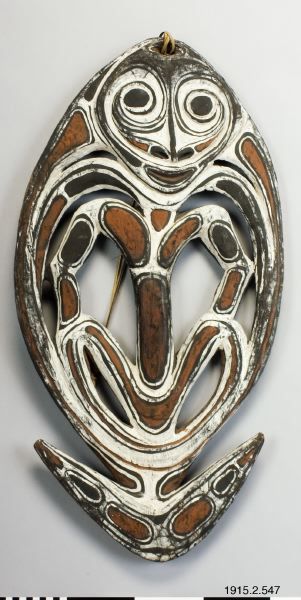suspension hook
- Description:
- Hook, cut as a human figure from a piece of heavy wood. Short arms and instead of legs it has down, against the hook a flat animal head with pointed backward ears and large eyes in white and black. Painted in red and white. pierced hole in the pan. Decorated with a crescent on the chest cut in low relief. Crooks like this are common in the middle and southern Sepik rivers. They hang both in ordinary dwellings and in cultural houses and have both profane and ceremonial significance. Their appearance gives no indication of their function. They can represent both human and animal figures, which for the owner are typical cow animals from mythology. In the family dwelling they can be used to hang up mesh bags with food to protect this from rats and dirt. The hooks hanging in the cult houses serve both ceremonial and everyday purpose. The hooks or rather the spirit (Wagen) with which the hook is loaded can be activated before eg. war raids. The important spirits, those who have significance for the whole village have their own servants/attendants who put themselves in trans and give the spirit a voice. The spirit is activated by keeping its attendants with chicken and betel nuts. These gifts are hung up on the hook and eaten by the “servant.” Only in this way can the spirit enter the servant’s body and communicate with people. The hooks that have a profane purpose in the dwelling can also be activated in this way, although they have a subordinate role compared to those that have significance for the whole society.
- Location:
- Papua New Guinea
- Format:
- image
- Collections:
- Museum of Ethnography
- Content partner:
- Museum of Ethnography
- Availability:
- Not specified
-
Copyright status: Share, modifyFind out more about what you are able to do with this itemMore informationMuseum of Ethnography has this to say about the rights status of this item:
http://creativecommons.org/publicdomain/zero/1.0/
What can I do with this item?Non-infringing useNZ copyright law does not prevent every use of a copyright work, and this item may be hosted by an international institute or organisation. You should consider what you can and cannot do with a copyright work.Share itThis item is suitable for copying and sharing with others, without further permission.Modify itThis item is suitable for modifying, remixing and building upon, without further permission.Check about commercial useYou'll need to confirm with the copyright holder using this item for commercial purposes.
Welcome and warm Pasifik greetings
The information on this site has been gathered from our content partners.
The names, terms, and labels that we present on the site may contain images or voices of deceased persons and may also reflect the bias, norms, and perspective of the period of time in which they were created. We accept that these may not be appropriate today.
If you have any concerns or questions about an item, please contact us.



